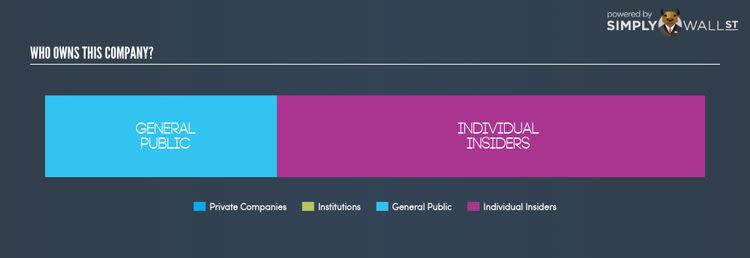Breaking Down Globus Maritime Limited’s (GLBS) Ownership Structure

In this article, I will take a quick look at Globus Maritime Limited’s (NASDAQ:GLBS) recent ownership structure – an unconventional investing subject, but an important one. Ownership structure of a company has been found to affect share performance over time. Differences in ownership structure of companies can have a profound effect on how management’s incentives are aligned with shareholder returns, which is why we’ll take a moment to analyse GLBS’s shareholder registry. All data provided is as of the most recent financial year end.
View our latest analysis for Globus Maritime
Institutional Ownership
Due to the big order sizes of institutional investors, a company’s shares can experience large, one-sided momentum, driven by high volume of shares removed from, or injected into, the market. The company hardly has institutions in its ownership structure, indicating limited concern for investors to worry about potential sell-offs that could arise due to extensive liquidation.
Insider Ownership
Insiders form another group of important ownership types as they manage the company’s operations and decide the best use of capital. Insider ownership has been linked to better alignment between management and shareholders. GLBS insiders hold a significant stake of 64.82% in the company. This level of insider ownership has been found to have a negative impact on companies with consistently low PE ratios (underperformers), while it has been positive in the case of high PE ratio firms (outperformers). It may be interesting to take a look at what company insiders have been doing with their holdings lately. Insiders buying company shares can be a positive indicator of future performance, but a selling decision can simply be driven by personal financial needs.
General Public Ownership
A substantial ownership of 35.05% in GLBS is held by the general public. This size of ownership gives retail investors collective power in deciding on major policy decisions such as executive compensation, appointment of directors and acquisitions of businesses. This level of ownership gives retail investors the power to sway key policy decisions such as board composition, executive compensation, and potential acquisitions. This is a positive sign for an investor who wants to be involved in key decision-making of the company.
What this means for you:
Are you a shareholder? Institutional ownership in GLBS is not at a level that would concern investors. We are less likely to see sustained downtrends or significant volatility resulting from large institutional trading. If you’re interested in bolstering your portfolio with new stocks and are looking for ideas, take a look at our free app to see my list of stocks with a strong growth potential.
Are you a potential investor? Ownership structure should not be the only focus of your research when constructing an investment thesis around GLBS. Rather, you should be examining fundamental factors like the intrinsic valuation of GLBS, which is a key driver of GLBS’s share price. Take a look at our most recent infographic report on GLBS for a more in-depth analysis of these factors to help you make a more well-informed investment decision.
NB: Figures in this article are calculated using data from the last twelve months, which refer to the 12-month period ending on the last date of the month the financial statement is dated. This may not be consistent with full year annual report figures.
To help readers see pass the short term volatility of the financial market, we aim to bring you a long-term focused research analysis purely driven by fundamental data. Note that our analysis does not factor in the latest price sensitive company announcements.
The author is an independent contributor and at the time of publication had no position in the stocks mentioned.


